
A live action role-playing game (LARP) is a form of role-playing game where the participants physically portray their characters. The players pursue goals within a fictional setting represented by real-world environments while interacting with each other in character. The outcome of player actions may be mediated by game rules or determined by consensus among players. Event arrangers called gamemasters decide the setting and rules to be used and facilitate play.
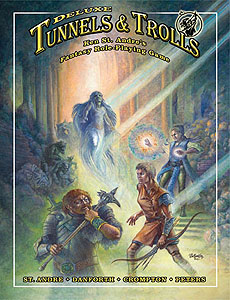
Tunnels & Trolls is a fantasy role-playing game designed by Ken St. Andre and first published in 1975 by Flying Buffalo. The second modern role-playing game published, it was written by Ken St. Andre to be a more accessible alternative to Dungeons & Dragons and is suitable for solitaire, group, and play-by-mail gameplay.

Peckforton Castle is a Victorian country house built in the style of a medieval castle. It stands in woodland at the north end of Peckforton Hills one mile (2 km) northwest of the village of Peckforton, Cheshire, England. It is recorded in the National Heritage List for England as a designated Grade I listed building. The house was built in the middle of the 19th century as a family home for John Tollemache, a wealthy Cheshire landowner, estate manager, and Member of Parliament. It was designed by Anthony Salvin in the Gothic style. During the Second World War it was used as a hostel for physically disabled children.

HeroQuest, is an adventure board game created by Milton Bradley in conjunction with the British company Games Workshop in 1989, and re-released in 2021. The game is loosely based around archetypes of fantasy role-playing games: the game itself was actually a game system, allowing the gamemaster to create dungeons of their own design using the provided game board, tiles, furnishings and figures. The game manual describes Morcar/Zargon as a former apprentice of Mentor, and the parchment text is read aloud from Mentor's perspective. Several expansions have been released, each adding new tiles, traps, artifacts, and monsters to the core system.

Dungeonland (EX1) is a 1983 adventure module for the Dungeons & Dragons (D&D) roleplaying game, written by Gary Gygax for use with the First Edition Advanced Dungeons & Dragons (AD&D) rules. It is an adaptation of Lewis Carroll's 1865 novel Alice's Adventures in Wonderland, with the various characters from the book translated into AD&D terms.

Eamon, sometimes known as The Wonderful World of Eamon, is a game creation system and a role-playing adventure game series created by Donald Brown and released for the Apple II in 1980. The game is a text adventure similar to other early titles like Adventure (1976) or Zork (1980) and to later text-based multi-user dungeons (MUDs), though with many role-playing elements not available in other interactive fiction. Eamon software is non-commercial and is freely available in the public domain.
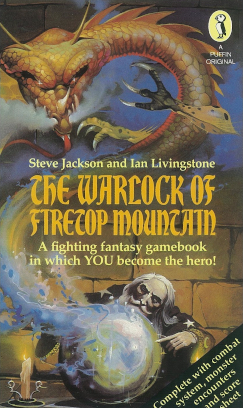
The Warlock of Firetop Mountain is a single-player adventure gamebook written by Steve Jackson and Ian Livingstone, and illustrated by Russ Nicholson. Originally published by Puffin Books in 1982, the title is the first gamebook in the Fighting Fantasy series. It was later republished by Wizard Books in 2002, and Scholastic Books in 2017. As well as launching the Fighting Fantasy series, the gamebook inspired two direct sequels and five novels, and has been adapted into a board game, an audio drama and a video game.

D&D Adventurers League is the organized play association for the Dungeons & Dragons (D&D) roleplaying game which is officially administered by D&D's publisher, Wizards of the Coast. It was rebranded with the launch of D&D's 5th Edition in 2014. Prior to 2014, it was known as the Role Playing Game Association Network. The organization was originally established by D&D's previous publisher, TSR, Inc., in 1980.

In Search of the Unknown is a module for the Dungeons & Dragons roleplaying game, designed for use with the Basic Set of rules. It was written by game designer Mike Carr and was first published in 1978 by TSR, Inc. The module details a hidden complex known as the Caverns of Quasqueton. Reviewers considered it a good quality introduction to the game that was written in the so-called dungeon crawl style, where the primary goal of the players is the exploration of a dangerous labyrinth to battle monsters and obtain treasure.
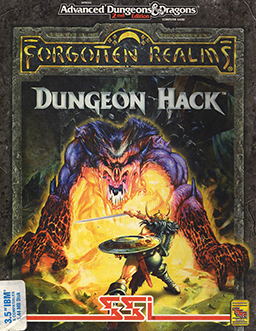
Dungeon Hack is a 1993 role-playing video game developed by DreamForge Intertainment and published by Strategic Simulations for DOS and NEC PC-9801.

Tecmo's Deception: Invitation to Darkness is a role-playing video game released by Tecmo in 1996 for the original PlayStation. Although often referred to simply as "Deception", the game's official title is Tecmo's Deception. Tecmo's Deception was released as Kokumeikan (刻命館) in Japan, and as Devil's Deception in Europe. The game inverts the common tropes of role-playing video games by placing the player in the role of an evil lord who must use traps and monsters to kill the adventuring parties which invade his castle. As the story progresses, the player character learns he has been the victim of multiple deceptions, and must decide whether to proceed with his plan to revive the Devil or convert to the cause of good.

Live action role-playing games, known as LARPs, are a form of role-playing game in which live players/actors assume roles as specific characters and play out a scenario in-character. Technically, many childhood games may be thought of as simple LARPs, as they often involve the assumption of character roles. However, the scope of this article concerns itself mainly with LARPing in a technical sense: the organized live-action role-playing games whose origins are closely related to the invention of tabletop role-playing games in America in the 1970s.
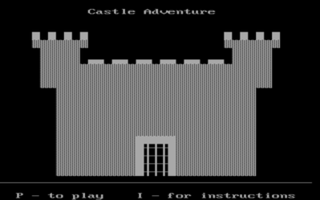
Castle Adventure is a freeware adventure game designed by Kevin Bales and released in 1984. It was also illegally included in Keypunch's Swords and Sorcery under the title Golden Wombat. It uses ASCII characters to display a castle map and moving creatures. It is compiled from Microsoft BASIC. The source code has never been released.
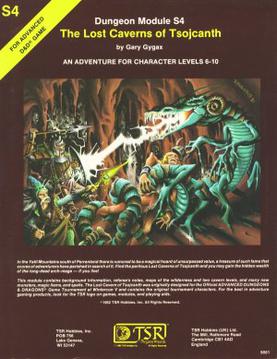
The Lost Caverns of Tsojcanth is an adventure module for the Dungeons & Dragons fantasy role-playing game. It was written by Gary Gygax and published by TSR in 1982 for the first edition Advanced Dungeons & Dragons (AD&D) rules. The 64-page adventure bears the code "S4" and is set in the Greyhawk campaign setting. It is divided into two parts, a 32-page adventure, and a 32-page booklet of monsters and magic items. The plot involves the player characters investigating rumors of lost treasure. After traversing a wilderness and two levels of dungeons, the players face Drelnza, the vampiric daughter of long-deceased archmage Iggwilv.
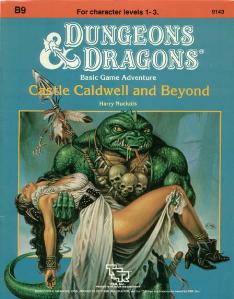
Castle Caldwell and Beyond is an adventure module published by TSR, Inc. in 1985, for the Basic Rules of the Dungeons & Dragons fantasy role-playing game. Its product designation was TSR 9143.

Ghost of Lion Castle is a 1984 adventure module for the Dungeons & Dragons fantasy roleplaying game. Its module code is BSOLO, and it was written by Merle M. Rasmussen with cover art by Bob Maurus.

Dungeoneer is a non-collectible card game designed by Thomas Denmark and released by Atlas Games. Denmark is also credited for many of the illustrations of the cards. During each game turn, players alternatively take on the role of the "dungeon lord", who unleashes monsters and traps on his opponents, and of the adventurer who explores the dungeon trying to solve his quests. The game is won either by a dungeon lord who defeats all of his opponents, or by an adventurer who successfully solves three quests.
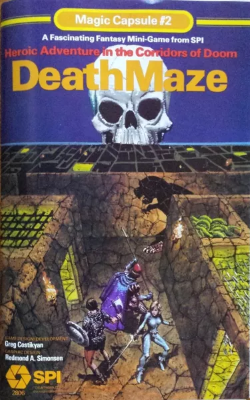
Deathmaze is a fantasy board game published by Simulations Publications (SPI) in January 1980 that falls into the general category of dungeon crawls, more specifically, dungeon games in which players enter a dungeon, massacre the dungeon dwellers and steal their treasures.
NERO International is a live action role-playing game (LARP) played in the United States. The NERO name originally was an acronym for "New England Role playing Organization", but the game has expanded well beyond its original New England roots and thus simply adopted the acronym as part of the official name.
Fools and Heroes is a non-profit fantasy live-action role-playing game (LARP) which was started in the autumn of 1985 by John Naylor, who placed a small advertisement looking for players in TableTop Games, Daybrook Nottingham. The first events were run in 1986 and the rules system was written and published by John Naylor and Steve Bell in 1986, by which point the national branch structure had already been established. The Society is democratic in nature and has multiple branches around the country. Most branches contain 15–20 members who play at least once a month, though some have as many as thirty. Members can travel between branches allowing them to play in various areas and interact in different plotlines. There are also yearly gatherings which involve multiple branches simultaneously, the largest of which is the Summerfest.



















